#DM Tips
Text
DM Tip - The constraints of D&D skill checks are not limited to 5e. Have them make a "Clumsy" check, or a "Clown" check or even a "Chaos" check. The only limits are the ones you put on yourself.
#dungeons and dragons#lol#being a dm#cant make this shit up#out of context stuff#critical role#brennan lee mulligan#DM tips#DM ideas#Funny#Bad advice
18 notes
·
View notes
Text
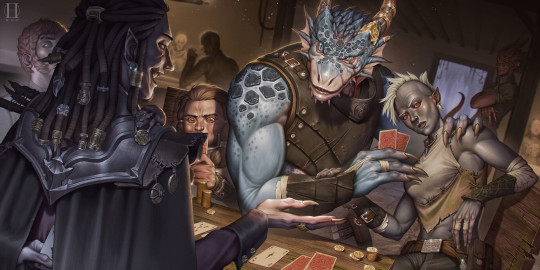
Dm Tip: Playing the Villain/ Guidelines for "Evil" Campaigns
I've never liked the idea of running an evil game, despite how often I've had people in my inbox asking how I'd go about it. I'm all about that zero-to-hero heroic fantasy not only because I'm a goodie twoshoes IRL but because the narrative-gameplay premise that d&d is built around falls apart if the party is a bunch of killhappy murder hobos. Not only would I get bored narrating such a game and indulging the sort of players who demands the freedom to kill and torture at will (I've had those before and they don't get invited back to my table), but the whole conceit of a party falls through when the obviously villainous player characters face their first real decision point and attempt to kill eachother because cooperation is a thing that goodguys do.
Then I realized I was going about it all wrong.
The problem was I had started out playing d&d with assholes, those "murder and torture" clowns who wanted to play grand-theft-auto in the worlds I'd created and ignore the story in favour of seeing how much unchallenged chaos they could create. They set my expectations for what an evil campaign was, and I spent the rest of my time developing as a dungeonmaster thinking " I Don't want any part of that"
But what would an evil campaign look like for my playgroup of emotionally healthy friends who understand character nuance? What would I need to change about the fundamental conceit of d&d adventures to refocus the game on the badguys while still following a similar enough narrative-gameplay premise to a hero game? How do we make that sort of game relatable? What sort of power/play fantasy can we indulge in without going off the deepend?
TLDR: In an evil campaign your players aren't playing the villains, they're the MINIONS, they're mooks, henchmen, goons, lackeys. They're the disposable underlings of uncaring overseers who have nothing but ill intent towards them and the world at large.
Where as in a hero game the party is given the freedom to challenge and overthrow corrupt systems, in an evil game the party is suck as part of that corrupt system, forced to bend and compromise and sacrifice in order to survive. The fantasy is one of escaping that corrupt system, of biding your time just long enough to find an opening, find the right leverage, then tossing a molitov behind you on the way out.
Fundamentally it's the fantasy of escaping a shitty job by bringing the whole company down and punching your asshole boss in the face for good measure.
Below the cut I'm going to get into more nuance about how to build these kinds of narratives, also feel free to check out my evil party tag for campaigns and adventures that fit with the theme.
Designing a campaign made to be played from the perspective of the badguys requires you to take a different angle on quest and narrative design. It’s not so simple as swapping out the traditionally good team for the traditionally bad team and vis versa, having your party cut through a dungeon filled with against angel worshiping holyfolk in place of demon worshipping cultists etc.
Instead, the primary villain of the first arc of the campaign should be your party’s boss. Not their direct overseer mind you, more CEO compared to the middle managers your party will be dealing with for the first leg of their journey. We should know a bit about that boss villain’s goals and a few hints at their motivation, enough for the party to understand that their actions are directly contributing to that inevitable doom.
“Gee, everyone knows lord Heldred swore revenge after being banished from the king’s council for dabbling in dark magic. I don’t know WHY he has us searching for these buried ancient tablets, but I bet it’s not good”
Next, you need a manager, someone who’s a part of the evil organization that the party directly interfaces with. The manager should have something over the party, whether it be threats of force, blackmail, economic dependency… anything that keeps the antiheroes on the manager’s leash. Whether you make your manager an obvious asshole or manipulative charmer, its important to maintain this power imbalance: The party arn’t going to be rewarded when the boss-villain’s plan goes off, the manager is, but the manager’s usefulness to the boss-villain is contingent on the work they’re getting the party to do. This tension puts us on a collison course to our first big narrative beat: do the party get tired of the manager’s abuse and run away? Do they kill the manager and get the attention of the upper ranks of the villainous organization? Do they work really hard at their jobs despite the obvious warning signs and outlive their usefulness? Do they upstage their manager and end up getting promoted, becoming rivals for the boss-villain’s favor?
Building this tension up and then seeing how it breaks makes for a great first arc, as it lets your party determine among themselves when enough is enough, and set their goals for what bettering the situation looks like.
As for designing those adventures, you’ll doubtlessly realize that since the party arn’t playing heroes you’ll need to change how the setup, conflict, and payoff work. They’re still protagonists, we want them to succeed after all, but we want to hammer home that they’re doing bad things without expecting them to jump directly to warcrimes.
Up to no good: The basic building block of any evil campaign, our party need to do something skullduggerous without alerting the authorities. This of course is going to be easier said than done, especially when the task spins out of control or proves far more daunting than first expected. The best the party can hope for is to make a distraction and then escape in the chaos, but it will very likely end with them being pursued in some manner (bounties, hunters, vengeful npcs and the like). Use this setup early in a campaign so you have an external force gunning for your party during the remainder of their adventures.
Dog eat dog: It’s sort of cheating to excuse your party’s villainous actions by having them go up against another villain who happens to be worse than they are. The trick is that we’re not going after this secondary group of outlaws because they’re bad, we’re doing it because they’ve either got something the boss wants, or they’re edging in on the boss’s turf. This sort of plotline sees the party disrupting or taking advantage of a rival’s operation, then taking over that operation and risking becoming just as villainous as that rival happened to be. This can also be combined with an “Up to no good” plot where both groups of miscreants need to step carefully without alerting an outside threat.
The lesser evil: This kind of plot sees your party sent out to deal with an antagonistic force that’s a threat not only to the boss’s plans but to everyone in general. In doing so they might end up fighting alongside some heroes, or accidentally doing good in the long run. This not only gives your party a taste of heroism, but gives them something in their back pocket that could be used to challenge the boss-villain in the future.
The double cross: In order to get what they want, the party need to “play along” with a traditional heroic narrative long enough to get their goal and then ditch. You have them play along specifically so they can get a taste of what life would be like if they weren't bastards, as well as to make friends with the NPCs inevitably going to betray. This is to make it hurt when you have the manager yank the leash and force the party to decide between finishing the job , or risk striking out on their own and playing hero in the short term while having just made a long term enemy. This is sort of plot is best used an adventure or two into the campaign, as the party will have already committed some villainous deeds that one good act can’t blot out.
Next, lets talk about the sort of scenarios you should be looking to avoid when writing an evil campaign:
Around the time I started playing d&d there was this trend of obtusely binary morality systems in videogames which claimed to offer choice but really only existed to let the player chose between the power fantasy of being traditionally virtuous or the power fantasy of being an edgy rebel. Early examples included:
Do you want to steal food from disaster victims? in Infamous
Do you as a space cop assault a reporter who’s being kind of annoying to you? in Mass Effect
Do you blow up an entire town of innocent people for the lols? in Fallout (no seriously check out hbomberguy’s teardowm on fallout 3’s morality system and how critics at the time ate it up)
I think these games, along with the generational backwash of 90s “edge” and 00s “grit” coloured a lot of people's expectations ( including mine) about what a "villain as protagonist" sort of narrative might look like. They're childish exaggerations, devoid of substance, made even worse by how blithely their narratives treat them.
Burn down an inn full of people is not a good quest objective for an evil party, because it forces the characters to reach cartoonish levels of villainy which dissociates them from their players. Force all the villagers into the inn so we can lock them inside and do our job uninterrupted lets the party be bad, but in a way that the players can see the reason behind it and stay synced up with their characters. The latter option also provides a great setup for when the party's actually monstrous overseer sets the inn on fire to get rid of any witnesses after the job is done. Now the party (and their players) are faced with a moral quandary, will they let themselves be accessories to a massacre or risk incurring their manager's wrath? Rather than jumping face first into cackling cruelty, these sorts of quandaries have them dance along the knife's edge between grim practicality and dangerous uncertainly; It brings the player and character closer together.
Finally, lets talk about ending the villain arc:
I don't think you can play a whole evil campaign. Both because the escalation required is narratively unsustainable, but also because the most interesting aspect of playing badguys is the breaking point. Just like heroes inevitably having doubts about whether or not they're doing the right thing, there's only so long that a group of antiheroes can go along KNOWING they're doing the wrong thing before they put their feet down and say "I'm out". I think you plan a evil campaign up until a specific "there's no coming back from this" storybeat, IE letting the Inn burn... whether or not the party allows it to happen, it's the lowest point the narrative will allow them to reach before they either fight back or allow themselves to be subsumed. If they rebel, you play out the rest of the arc dismantling the machine they helped to build, taking joy in its righteous destruction. If they keep going along, show them what they get for being cogs: inevitably betrayed, sacrificed, or used as canon fodder when the real heroes step in to do their jobs for them.
Art
#dm tip#dm tips#writing advice#evil party#drafting the adventure#dnd#d&d#dungeons and dragons#blades in the dark#ttprg#pathfinder
406 notes
·
View notes
Text
Every time I look at how to create a world for a campaign or just plan a campaign on the internet you usually get : start small with the town and maybe the few places around, you don't need to know everything about the world to start the campaign.
However what if your players want to create characters that come from beyond that place. You'll need to tell them what the world is like, what others kingdoms and lands there are and what is happening in there for them to be able to put their character in there and know what is going on so they have some guidelines about the world's alliances etc ?
How do you do ? (Also if I'm looking at it wrong please tell me I am but an aspiring DM)
392 notes
·
View notes
Text
Brennan Lee Mulligan on TPKs
"The easiest feeling of dread I feel as a dungeon master is in a difficult combat when players start changing their mind turn to turn about what the overall strategy is.
That has presaged every TPK I've ever seen. The only times that all the players get wiped out is when someone's like 'We gotta run' and they spend their turn runninng, and the next person is like 'I'm gonna follow them' and the third person says 'Shit, the artifact! I'm gonna swing twice and get the artifact' and then person number four goes 'Are we staying or are we running? I'm gonna cast a spell to try to pull the artifact, OK they saved, shit umm, I'm gonna move into this hedge for better cover for next round' and the first person is like 'Next round?! Well I'm gonna run back then!' and now you're blowing your action economy, and the damage is piling up, and that's when people die."
Worlds Beyond Number Fireside Chat for WWW ep11 "Promises Promises"
939 notes
·
View notes
Text
Just a friendly reminder for DMs: Many brands of wrapping paper has a 1x1in grid on the back, the perfect size for d&d maps, and all the holiday paper is currently on sale
956 notes
·
View notes
Text
This is I think, my best prep tip as a DM:
When the players are about to visit a new town, pre-generate several NPCs who fit the demographics of the town, but don't give them jobs. Your town is Mostly human, with a number of halflings and gnomes? Make a list that's mostly humans with some halflings and gnomes mixed in, with names that match the vibe you're going for and maybe the barest description + a quirk of some sort.
So the list would look something like this:
Ophelia Bracegurdle, older Halfling woman who laughs a lot
Norabecka Johnson, a young human woman who seems tired
Geraldofinio Babblecock Nimsy, gnome gentleman who takes pains to maintain a fabulous mustache
Etc.
Then, when the players are like, "Can I go to the blacksmith?" You look at your list of NPCs and the one at the top is Ophelia Bracegurdle. She's your blacksmith now. Then they want to go to the tavern, where Norabecka is the innkeeper and Geraldofinio is a patron having a drink at the bar. He's using a straw so he doesn't mess up his mustache.
If they had gone to the inn first, Ophelia would have been the innkeeper with Norabecka as the patron, and then Geraldofinio should have been a blacksmith with some sort of mustache guard to keep the sparks off.
Making the list ahead of time doesn't take much time, and you can often re-use the people you never got to at the next town.
Your world will seem vibrant and interesting and like you have everything planned out.
Have fun!
3K notes
·
View notes
Text
if you are a dungeon master (or even a fantasy author/worldbuilder of any kind) and you don’t know about donjon let me make your life a million times easier
want to make a fantasy calendar with your own year-lengths, weeks, months, and lunar cycles? https://donjon.bin.sh/fantasy/calendar/
need to come up with some medieval town demographics? https://donjon.bin.sh/fantasy/demographics/
want to make a map and layout of a city/town? https://donjon.bin.sh/fantasy/town/
want a fleshed-out tavern complete with menu, innkeeper, patrons, rumors, and secrets? https://donjon.bin.sh/fantasy/inn/
leading your players through a dungeon and want to customize the size, treasure, layout, theme, etc? https://donjon.bin.sh/5e/dungeon/
tired of creating lists of magic items for different shops to sell, or hoards to be looted? https://donjon.bin.sh/5e/magic/shop.html and https://donjon.bin.sh/d20/treasure/
even a customizable initiative tracker! https://donjon.bin.sh/d20/initiative/
and that’s only scratching the surface! I really recommend all dms check this out. oh, and it’s completely free!
#donjon#dm#dungeons and dragons#d&d#gm#worldbuilding#cr#dm tips#dm advice#ttrpg#game master#dungeon master
405 notes
·
View notes
Text

Roleplaying tip: Use props to get into character and keep players excited and engaged (The Bot Abusers Manual, supplement for Paranoia, West End Games, 1992; interior art credited to Rob Caswell with Michael Vilardi)
203 notes
·
View notes
Text
Guys! I cracked the code! I wish I had any followers to share this magic revelation I had!
In D&D I love being a DM. I really do. With one exception.
Money.
Knowing how much a character should buy or sell something for is just way out of my grasp. For a rare item the price can be anywhere between five hundred and five THOUSAND. That’s a big difference! How am I supposed to know in between those two numbers what it should be?
I googled. And googled. And googled. Thinking *there must be a better way* and couldn’t find a single thing that made sense. Well me and two other DM friends got together and we figured it out. The magic system of pricing.
So first you take the pricing by magic item rarity in the DMG

Then you go to Xanathars and look at the Magic Item Tables to determine if the item is major or minor
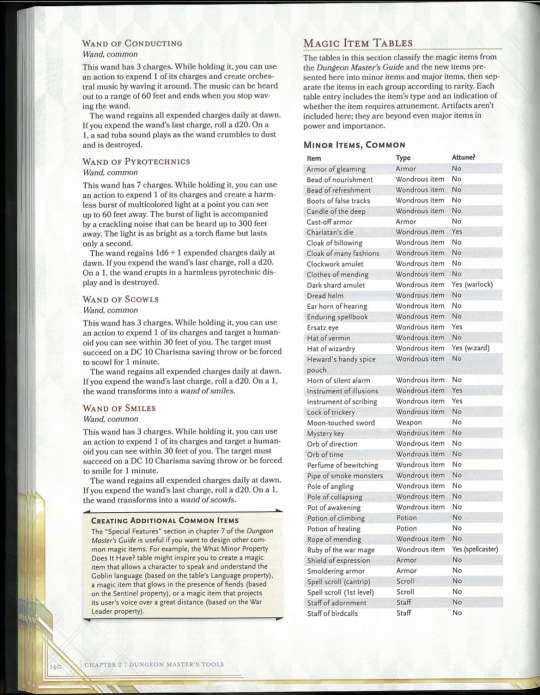
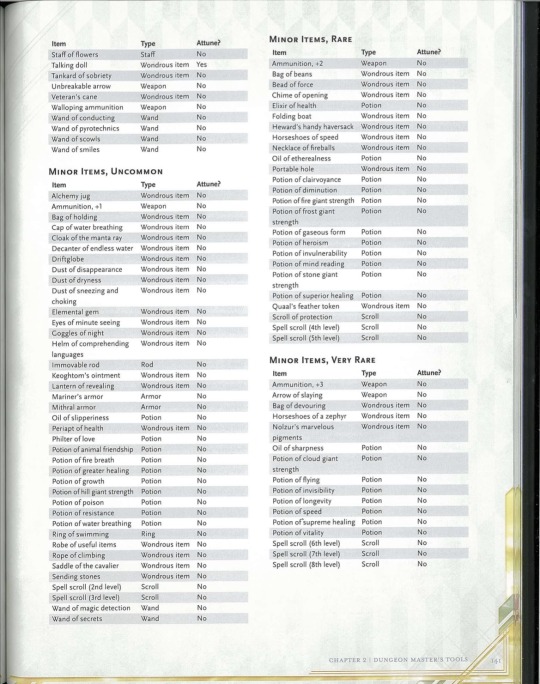
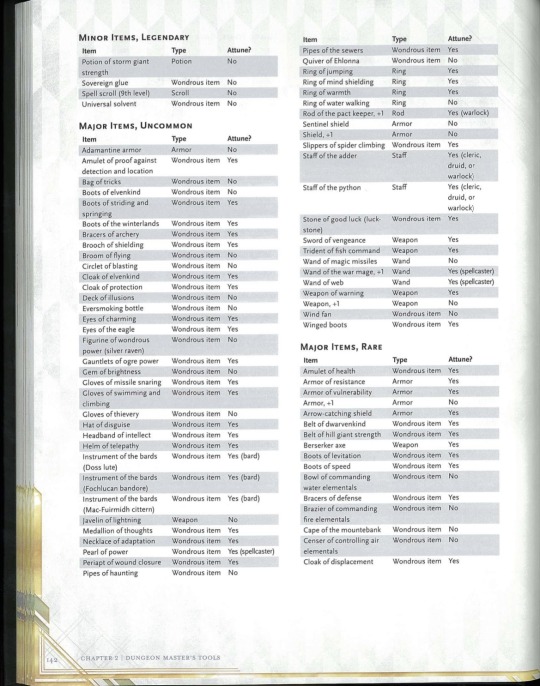
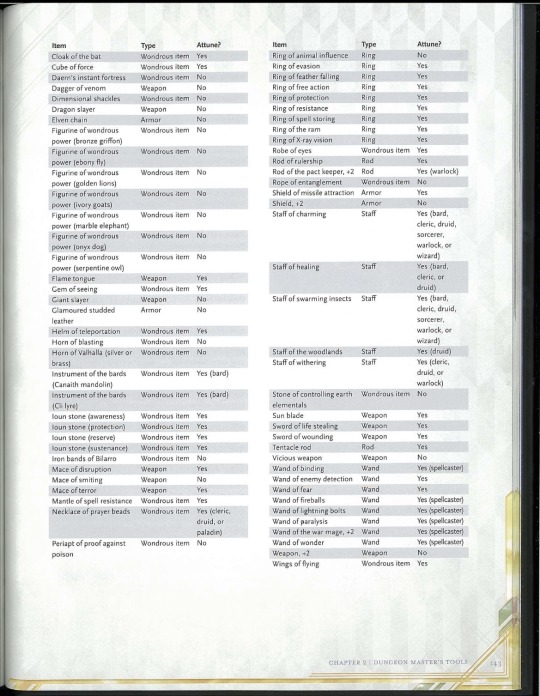
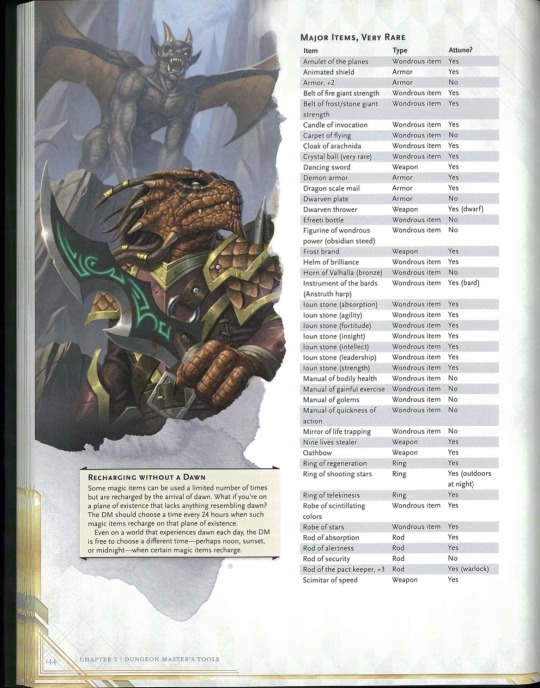
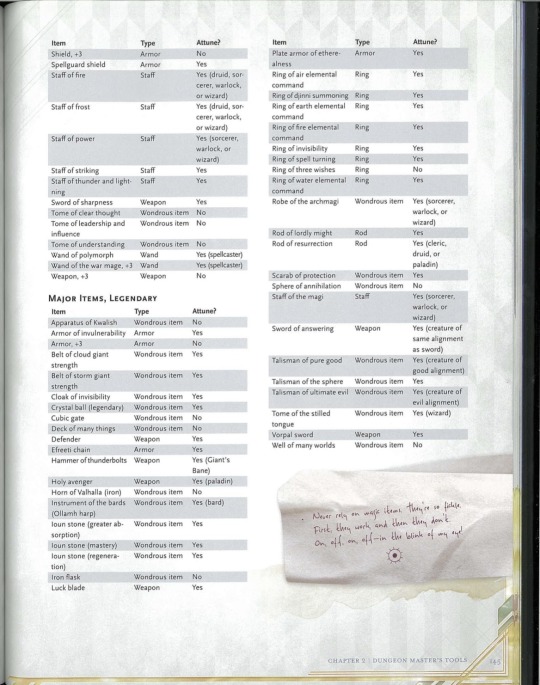
Divide the prices in the rarity into major and minor. Major the higher half and minor the lower.
So that makes
Rare Minor - 500 - 2,500
Rare Major - 2,501 - 5,000
Very Rare Minor - 5,001 - 30,000
Very Rare Major - 30,001 - 50,000
Legendary Minor - 50,000 - 300,000
Legendary Major - 300,000 - 500,000
Then
THEN
It’s all up to a persuasion roll. Because let’s face it, what’s a fantasy shopping adventure of magic items without bartering and haggling?
So you divide the amounts into roll milestones. So a persuasion roll of 0-10 you pay the highest and 20+ you pay the lowest.
Like so:
Common Items: 1d6 x 10
Uncommon Items 1d6 x 100
Rare Minor:
0-9: 2,500
10-11: 2,100
12-14: 1,700
15-17: 1,300
18-19: 900
20+ : 500
Rare Major
0-9: 5,000
10-11: 4,600
12-14: 4,200
15-17: 3,800
18-19: 3,200
20+: 2,500
Very Rare Minor
0-9: 30,000
10-11: 25,000
12-14: 20,000
15-17: 15,000
18-19: 10,000
20+ : 5,000
Very Rare Major
0-9: 50,000
10-11: 45,000
12-14: 40,000
15-17: 35,000
18-19: 30,000
20+ : 25,000
Legendary
0-9: 250,000
10-11: 200,000
12-14: 150,000
15-17: 100,000
18+ : 50,000
Legendary Major
0-9: 500,000
10-11: 450,000
12-14: 400,000
15-17: 350,000
18-19: 300,000
20+ : 250,000
Seriously someone who is followed by a lot of D&D people find this shit and spread it! It’s so much easier and makes a million times more sense then anything I ever heard of before and i wish someone else would have thought of it sooner (or if someone else did that I had found it sooner)
#dungeons and dragons#dnd#D&D#magic items#DM#dungeon master#DM tips#Dungeon master tips#dungeons and dragons tips#dnd tips#D&D tips#someone please make this famous#why hadn’t I found this earlier#holy shit#i don’t know how to tag
1K notes
·
View notes
Text
fun dm tip
if your players roll a perception check and ask "is there a [insert specific thing that I definitely didn't design but go off queen] nearby"
say
yes
always
#within reason#“is there a flamethrower”#rolls nat 1#“yeah and somehow you tripped over it and are on fire”#“whoops”#"yeah:#dming#dnd character#dnd#dungeons and dragons#dnd5e#ttrpg#dnd ocs#homebrew#funny#tabletop rpg#dm tips
137 notes
·
View notes
Video
youtube
AAAWWW DANNNGGG Another Felix tips video animated by our talented friend Vitamin Ditter This ones to help improv your way out of things as a DM (I personally needed this advice ;u;)
194 notes
·
View notes
Text
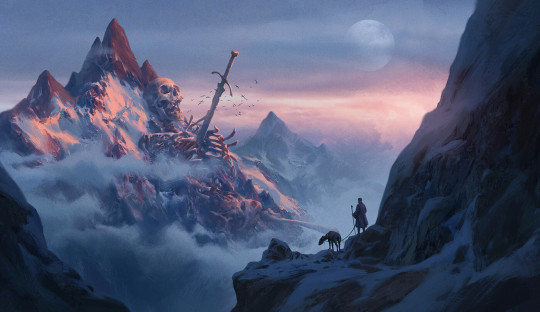
DM Tip: Creating a Campaign Skeleton
Learning to be a better dungeonmaster was a protracted process. A younger me was often so stressed out by the desire to be a better artist that I'd have legitimately mauled a person if it would've revealed to me the wisdom I sought (with my hands or even an actual maul given the chance).
One of my biggest hurdles was the idea of a universal framework for d&d adventures, a guideline that would tell me if the things I was creating were on the right track. It was sorely needed, I loved the process of being creative but without an understanding of how my creative energy was best used I ended up sinking days, weeks, or even months worth of energy into projects that went nowhere. Worse yet, when I DID get a chance to put my ideas into practice at the table they'd frequently spiral out of control and crash, resulting in even more stress.
Over time I learned from these mistakes, I got better, and then I got good. I moved from conscious incompetence to competence, and I ended up having a run of absolutely stellar campaigns that were everything my younger self could have dreamed of: stable, enjoyable, meaningful, and most importantly an absolute delight to my players. Routinely I'd have people, including folks that'd only played with me a few times, mention that getting together to roll dice and listen to me babel on in silly voices was a highlight of their week.
It was as one of these campaigns began to wind down (three years! a satisfying conclusion on the horizon!) and I started looking for a followup scenario that I decided to study all my really successful campaigns and figure out what connected them. The end result was something I'd been looking for for nearly a decade, a reliable format that I could build campaigns around.
I want to preface this section with the understanding that while this information is laid out in a vaguely chronological fashion there's no guarantee that these ideas will occur to you in any particular order. Inspiration is a funny thing, and each idea flows into the others to make a cohesive whole. Due to foreshadowing and setup reasons you're also going to need a pretty solid idea about all of these when starting a campaign, though exact details will likely change/ can be vague up until the moment they're needed.
The Reason: Who are we and what are we doing?
Gives your players a solid background to build their characters around and give them a reason to travel together, rather than having to ad lib one on the spot.
Likewise sets expectations of what the campaign is "about" that you can build on or subvert in time.
The reason doesn't need to hold true for the entire game, just long enough to serve as a framing device. EG: The Witcher starts out as a "monster of the week" setup and then uses that framework to pivot into politics and prophecy once we've seen the premise play out.
The Pilot/Crashtest Adventure: What's first?
I’ve already written about these, but the general concept is to give your party a mostly contained first outing that doesn’t have any larger bearing on the plot so they can focus on learning how their characters play/building the party dynamic.
By the time the party's finished this first adventure they'll have already started putting down roots in the world: they'll have in jokes, npcs they've started to care about, an understanding of what's on the horizon, and an idea of where they want to go next.
The Central Gameplay Pillar: How does this all work?
It's important to have an idea what your campaign is going to be about in a mechanical sense in addition to its plot and themes. There is a difference between an adventure that has the party delve a dungeon, and a dungeoncrawling focused campaign.
I like to lead with these outright during the campaign pitch so that players can know what they're getting into. Your playgroup will likely have strong opinions about what they like and dislike, even if they don't have the words to describe it, so you might need to explain the ideas for them.
The Hub: Where are we?
I think every good campaign has a hub, some kind of settlement that the party returns to between adventures to offload loot, pick up supplies, and sift through the latest gossip to look for the next questhook. Letting the party return to the same place lets them build up a relationship with it, clarifying the picture in their mind as new details are added and they grow more and more attached. It's possible to have multiple hubs over the course of a campaign, but I'd advise really only having one per arc to best concentrate your efforts.
Fill up your hub with distractions and side adventures, shorter stories that the party can get tangled up in while the larger adventure slowly reveals itself.
Returning to the same hub also means returning to a familiar and expanding cast of NPCs, which helps your party become more and more invested in the setting
The Main Event: What's going to happen?
Here we get to the meat of the issue, the big story you want to be telling using this campaign. To pull off the sick narrative kickflip you wish to perform, you're going to need to lay a lot of groundwork, seeding in details left and right as well as giving the party a chance to stumble across evidence of your schemes without ever realizing the whole thing.
To do this, you're going to work in the building blocks of your big reveal/twist/pending disaster into the setting along with those side adventures from the hub. This will give your party an idea that something is going on, but with more pressing matters to take care of they're going to be distracted up until the moment you decide to pull the trigger.
The Setting: What's over there?
While things like genre and tone are definitely things you should have a handle on from the outset, I personally feel like the details of a setting are best constructed on an ad hoc basis, either in a direct response to something required by part of the narrative (be it side story or main event), or pencilled in at the margins as the party explores the world..
That said, creation of the hub and setting often go hand in hand because it's important to match the settlement to the environment and then shape the environment to the quests inside the settlement.
As for what's beyond your hub, I happen to have just written something about building out settings.
Now, this next option is one that I recommend you start thinking about only once your campaign is fully underway, so it doesn't clog up your creative process by focusing on something that you might not even get to
The Change: What the fuck?
A little while after the main event has kicked off and your party is off on the quest that will turn them from mere adventurers into heroes, they start to hear rumours of strange happenings. It's certainly not related to the present scenario, it may even be an unexpected windfall, but it's not something they have time to look into.
Time ticks on, the land is saved, and the party is able to enjoy their victory lap as well as some dearly needed time off. Before they can get comfortable however they're slammed by some strange occurrence that they could have never predicted that changes the state of the world. A neighbouring kingdom invades, an important ally is murdered and they're blamed for it, a dragon starts rampaging through the realm.
Its important that this event is outside the party's skillset, not necessarily diametrically opposed, but counter to what they were planning
artsource
316 notes
·
View notes
Text
DM Pro tip - the "Recap" at the beginning of your session is your excuse to be EXTREMELY passive aggressive to your players and what they DIDN'T do.
#dungeons and dragons#being a dm#out of context stuff#dying inside#someone help me#brennan lee mulligan#critical role#lol#DM tips#dm advice#dungeon master#dnd campaign
88 notes
·
View notes
Text
Hey all, This is my first Tumblr post ever! I'm pretty new here, but I'm hoping to share some DM techniques, tools and tips and to make some new friends as well! Feel free to send a chat request (an ask[?]) if you're interested!
With that aside, on with the post!
Better and More Meaningful Random Encounters!
Random encounters are a staple of DnD, they are expected to be there during exploration as a way to make the world feel alive, to have it have an aura of adventure and danger, to eat up party resources and put pressure on the PCs to make interesting and important choices, and also as a way for a DM to reasonably 'stall' the party with a quick and easy situation.
Usually, it ends up something like this:
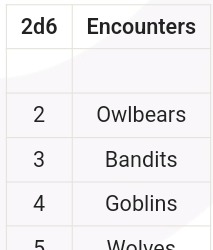
There's just one problem with most random encounter tables though, it's so easy for them to be GOSHDARN BORING! Especially for a newer DM.
Making them interesting becomes gambled improv on the DM's part if they're not used to it, and it's hard to keep track of the important factors that need to be kept in mind
Luckily, I ended up finding a great source for random encounters from 'Dungeon Masterpiece' on YouTube, and I integrated it into my own DMing. I figured that I'd share it here for any that want to work it into their own sessions as well!
After adjustment, a single table can account for multiple entire sessions of in-depth worldbuilding and fun without getting dull!
Sources:
Source 1 (Creating interesting Random Encounter Tables):
youtube
Source 2 (Making Random Encounters reflect your Worldbuilding):
youtube
There's 4 major methods we can use to improve the Random Encounter table
1. Make the table a straight 1dx roll.
2. Adding 'depth'.
3. Adding meaningful encounters.
4. Prerolling and/or Multirolling.
You can also check out the "Where to Start?" section for some direction to make getting it down and prepped all easy peasy!
1. Straight Roll:
Its enticing to go for 2d6 or the such in order to add non-linearity to the rolls, but these sorts of adjustments only end up making one or two encounters extremely likely and leave all others in the dust, it often ends up defeating it's own purpose of interesting randomness.
In the previous example, it was extremely likely to only get Wolves, Barbarians, Orcs, or Spiders, from a table of 12! A straight roll would serve us much better. The rare rolls are already rare enough as is!
Simply enough, adjusting the original example by replacing the 2d6 with 1d12, it'd become something more like this:
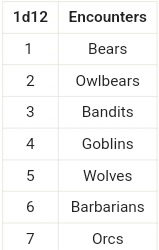
#2. Adding Depth:
We can add more columns in the encounter tables. These columns will represent different aspects about the encounters that we can roll on separately!
Usually it can be difficult as a DM to naturally come up with motives for the encounters, showcase the worldbuilding and have it all come together.
This setup can give you a solid guideline on how the creatures/people think (if any), and also sets up the overall area so that you get an idea of what events tend to occur there as a result of its occupants.
We want to add 3 more columns to the tables to convey different aspects of the encounter. Fill in these new columns corresponding to the expectations of each encounter.
We'll roll each of these and combine them, then we'll interpret them to make a robust, in-depth random encounter with truly unexpected results!
I recommend rolling alot of complete encounters at once and interpreting the context to the vast general area the party is travelling in.
i. Behaviour: How the creatures act. Are they friendly, scared, aggressive, curious, mischievous?
ii. Complication: Something behind the scenes in the encounter. Do they have sick young? Broken equipment? Are they starving?
iii. Significant Impact: This is a tick box, and will only be present under ONE of the rows. It will be rolled like the other columns, but ONLY once. It signifies which encounter is the Significant Encounter
The Significant Encounter will have its encounter's presence prominent amongst all the other random encounters in the area. There could be burn marks and carcasses from a rampant dragon, or a goblin raid leaving tracks moving through the area. Which is the most impactful of the different encounters?
Adding this to our previous example would expand it to:

Rolling this would give us things like:
Significant encounter: Owlbears

Note that the significant impact shows that the Owlbears are a massive problem in the area. Perhaps the Owlbears are agitated for an unknown reason, and are unnecessarily aggressive.
The significance of Owlbears gives us context to the second one as well! Perhaps the hunters raided an Owlbear den, and adopted an Owlbear cub from there as well.
There could be uneaten carcasses, ravaged trees, less wildlife, etc around these parts.
Note how much sheer CONTEXT these columns add to our encounters. It's invaluable!
3. Adding Meaningful Encounters
Usually random encounters tend to be rather mundane and very one-note.
There's usually some general wildlife and monsters, different disparate factions without any rhyme or reason, and maybe a general non-combat encounter or two, but these don't really tell us about the area or its surroundings at all by themselves.
Instead, we can add in wildlife and monster encounters specific to the biome, non-combat encounters, and encounters of nearby factions and/or settlements to the table, and we can even add environmental encounters in there as well.
Note that we're not tied down to 12 encounters, and can expand it ad infinitum according to our need of diversity in our encounters.
Just add in specification and connection, and suddenly the dominos all fall into place.
Lastly, we'll also be adding in 'DOUBLE TIME' which will let us roll on everything twice, and make it so it's a double encounter!
Thus, the table can instead be adjusted to:
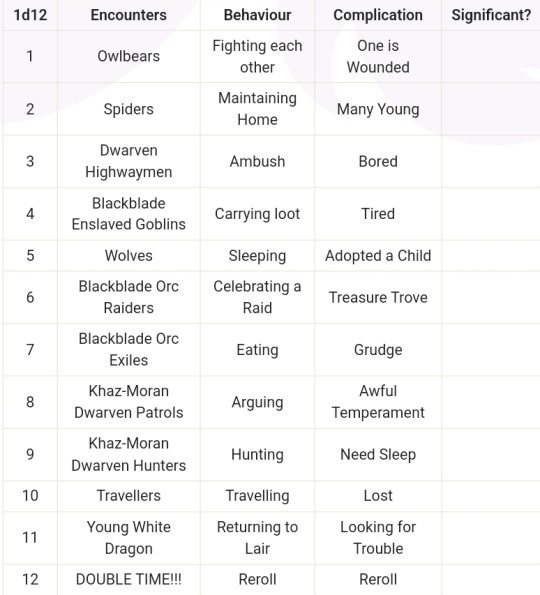
Note how each and everything has its relation in one way or another, but through the sheer variance, they remain truly random and novel.
4. Prerolling and/or Multirolling
Lastly and this is just something that I do, but that I found gamechanging. Be sure to pre-roll 5-7 encounters for each session, for the general area the players are going to be headed in.
Note that you don't need to really prep anything at all, just interpret all of them on a surface level as a buffer.
Also note that you don't need to use all of them if they're not needed. The foreshadowing and signs are worldbuilding and having secrets that the players don't unravel is just as useful as the ones that they do, perhaps even moreso. It adds depth and detail beyond the scope of what the party will encounter
It simply let's you get an idea of the connections between encounters, allows for foreshadowing, and acts as a deterrent to getting caught off guard.
Even if you roll mid-session, I recommend calling for a 5 minute break, rolling 5-7 encounters at the same time and interpreting them and their connections before resuming the session.
It WILL make a difference, trust me
Where to start?
It can be difficult getting inspiration or direction to get started in creating these random encounters, and sometimes you don't want to go through the hassle of thinking them up from nothing
For some great conceptual headstarts and examples for these tables, you can check out 'Worlds Without Number' and it's:
- Page 205 (Great general templates for encounters differentiated by broad creature types such as Beasts and Monsters, Sapient Monsters, and Humans)
- Pages 206-219 (For inspired locations to occasionally run rare encounters or groups of encounters in. This works best with flexible/discovered worldbuilding given the significance of some of these, and you also want to add these in sparingly to keep them significant)
- Pages 246-247 (These pages have great templates for the kinds of encounters and situation to be included in the tables, and it can be expanded vastly, and certain options can be selectively and repeatedly chosen to meet our needs. Mood works well as a complication.)
There might be other pages that are useful as well for these sorts of random encounters in the wilderness that I haven't come across yet. If so, give them a shout out and I'll be sure to add them in. It's worth checking it out in its entirety for some great tips!
Conclusion
Again, credit goes to Dungeon Masterpiece and Worlds Without Number for excellent adjustments. This has been quite long, but I hope you stuck around till the end.
Many a session have been made easy but complex ever since this was introduced and I hope that this helps you out as much as it helped me in my prep and improv!
Feel free to give any advice in formatting on Tumblr, or any feedback on the post itself. It really means a lot to me, thanks!
#dm tools#dungeons and dragons tips#dungeon master tips#dm advice#dm tips#ttrpg#dnd#Youtube#dnd resources#gm tips
58 notes
·
View notes
Text

what do you think?
pointsofinspiration.com
#dnd#dungeons and dragons#ttrpg#dungeon master#dm tips#dnd5e#dm advice#pathfinder#fantasy#dungeon master tips
91 notes
·
View notes
Text
DM\GM Tip on Roleplaying Stuff
🎲 GMs, there’s always a way to say yes to what the player wants to do.
🎭 Roleplay isn’t always about getting what you want but being given the chance to try and it doesn’t mean success is always possible.
💪 I once had a Barbarian whose whole purpose was to fight the biggest things he could find.
🌋 The first time he saw a Volcano, he wanted to fight it. Both me and the player knew that wasn't possible. But I gave him the chance to play this out.
He attempted to scale the side while his party looked on, dumbfounded. He eventually fell...multiple times. Until he swore, he would return when he was stronger to exact revenge.
Sometimes players will want to do things and not understand that it's not possible yet -- could be due to power levels, influence, ect.
🧙♀️ Don't just deny them the opportunity. Talk, communicate expectations and give them chances to work towards those goals.
#Dungeon Master#Game Master#DnD#D&D#Dunngeons & Dragons#Dungeons and Dragons#TTRPG#DM Tips#GM Tips#DM Advice
113 notes
·
View notes